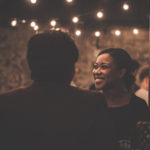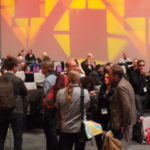When 5,000 Boston Scientific employees were(bold) led by groups of 300 into a darkened room at the Minneapolis Convention Center last September, they could tell immediately that this annual All-Employee Meeting for regional operations would not be the usual fare of general-session speakers and panel discussions. After a short video, the curtain rose to reveal an open, bustling floor filled with intimate gathering spots, iPad bars, and large-screen monitors broadcasting presentations going on throughout the center.
Instead of all the attendees filing into a general session, they gathered in café-style salons for short, engaging presentations and discussions. In other words, they participated in a total sensory experience.
“Boston Scientific wanted to inspire the employees and celebrate their success,” said Samuel J. Smith, event technology consultant and managing director of Interactive Meeting Technology, who was hired by Boston Scientific for the event. “The company had been doing a lot of great things… [and they wanted] to help people reconnect with the core purpose of the company, so they [would] walk out with a renewed sense of passion and hopefully remember why they actually joined Boston Scientific to begin with.”
With a wide range of employees — from factory workers to senior executives — attending, the challenge was to engage and give everyone the individualized content they needed, Smith said. A year earlier, the company had used a “museum style” approach to increase attendee interaction. This year, senior executives asked, could Boston Scientific get the same kind of return at a lower cost?
“We tried to create that type of environment to get people to talk to each other on the things they were passionate about,” Smith said. “If we built the content in these cafés, people would engage with that content in different ways, and that would help spark passion, plus create space for conversation. When you look at engagement, people don’t want to participate in the same way. Some people create, some people critique, and some people collect things.”
Thought leaders and facilitators at the eight cafés generated conversations, gave short presentations, and kept discussions on track. One of the cafés was a 1,500-seat theater, Smith said, designed to create amore intimate experience for everyone. Award ceremonies and patient case studies at the theater were broadcast throughout the convention center on large-screen monitors so attendees at other cafés wouldn’t miss out.
At one café, you might have a raucous, highly active discussion, Smith said, while across the hall, a group would be quietly riveted to a case study presented by a colleague. Chances were, though, both groups were hearing the same message, Smith said, “presented in different ways, so that people could get the information in the way they wanted.”
The iPad gaming bars incorporated content into games—such as a “leadership line-up,” in which players tried to identify photos of company executives. Activity on the gameboards was streamed in real time to organizers and analyzed for senior leadership. With 1,200 gameplays in two hours, organizers knew that employees were actively learning and engaging with the content – and company executives had no problem green-lighting the café concept for their other meetings.
Take Away: Follow the Leader(board)
At Boston Scientific’s All-Employee Meeting, 300 iPads were placed throughout the Minneapolis Convention Center, each filled with hundreds of questions written by employees on themes such as leadership, company initiatives, and new products. Correct answers boosted players’ scores for a chance to win an iPad and to see their name and photo displayed on a leaderboard.
“For some folks, the prize was getting on the leaderboard,” said Interactive Meeting Technology’s Samuel J. Smith. “It was a glory moment. And, they learned from each other. If they got a wrong answer, they would pass or they would ask each other for help with the question. It became a way for people to really connect with each other and ideas. They learned more about the company from doing this than any of the other challenges.”



